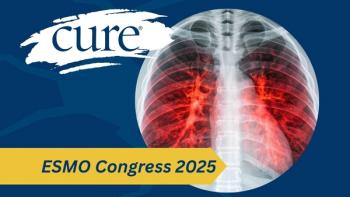
Blood Test Can Predict Patients at Risk of Dying from Lung Cancer
A blood test protocol proved to be more effective than US Preventative Services Task Force criteria for predicting which patients are at a higher risk of dying from lung cancer.
A blood test, when combined with individualized risk factors, may help predict a patient’s risk of dying from lung cancer, according to recent research published in the Journal of Clinical Oncology.
The blood-based panel, called 4MP, measures four proteins in the blood that may help predict lung cancer risk. When combined with PLCOm2012 — a prediction model that includes 11 factors such as age, race, body mass index, chronic obstructive pulmonary disease, cancer history and more — the team of researchers from The University of Texas MD Anderson Cancer Center discovered a better rate of success of predicting which patients were at high risk of dying from lung cancer than the current US Preventative Services Task Force (USPSTF) criteria.
“This simple blood test has the potential to save lives by determining the need for lung cancer screening on a personalized basis,” co-corresponding author Dr. Samir Hanash professor of Clinical Cancer Prevention, at MD Anderson said in a press release. “Given the challenges associated with CT as a frontline screening method for lung cancer and the fact that most individuals diagnosed with the disease do not meet current guidelines, there is an urgent demand for an alternative approach."
To conduct the study, data from 552 patients who developed lung cancer — 387 of whom (70%) died within the six-year time frame of the research — were analyzed. The researchers calculated relationships between the risk scores calculated by 4MP plus PLCOm2012 and lung cancer death, and discovered that this method was more likely to accurately predict the risk of lung cancer death than the 2013 and 2021 USPSTF criteria for predicting lung cancer-specific mortality among individuals who smoked at least 10 pack-years. A pack year is a way to measure the amount of cigarettes smoked over a period of time, and is calculated by multiplying the number of packs of cigarettes smoked per year by the number of years the person has smoked, according to the National Cancer Institute.
These findings coincide with prior research conducted by Hanash and colleagues that found that the PLCOm2012 model can help identify patients without a history of lung cancer who would benefit from screening — including those who may be missed by the USPSTF guidelines.
Of note, clinicians across the country follow USPSTF screening recommendations, which can also influence insurance coverage of such procedures, according to the Centers for Disease Control and Prevention. The current recommendations suggest that adults between the ages of 50 and 80 who have at least a 20 pack-year history of smoking and currently smoke or have quit within the past 15 years undergo yearly CT scans to monitor for lung cancer.
Despite the success of 4MP plus PLCOm2012 in this trial, the study authors noted that in order for the protocol to be approved by the Food and Drug Administration, it would likely have to be further tested in a clinical trial.
However, one of the study authors explained that this model has the potential to impact cancer screening around the globe.
“For individuals who currently are not eligible for lung cancer screening, a positive test may help to identify those possibly at risk for lung cancer death,” co-corresponding author Dr. Edwin Ostrin, assistant professor of general internal medicine at MD Anderson, said in the press release. “We envision this as a tool that could be deployed worldwide, as the future of early detection of this disease.”
For more news on cancer updates, research and education, don’t forget to





